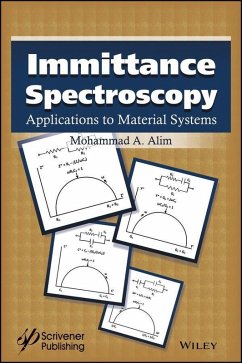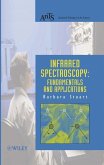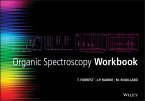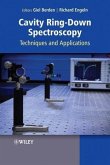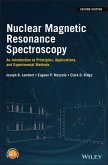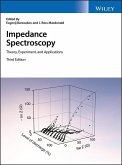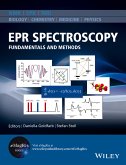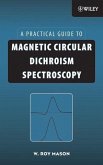

Alle Infos zum eBook verschenken

- Format: PDF
- Merkliste
- Auf die Merkliste
- Bewerten Bewerten
- Teilen
- Produkt teilen
- Produkterinnerung
- Produkterinnerung

Hier können Sie sich einloggen

Bitte loggen Sie sich zunächst in Ihr Kundenkonto ein oder registrieren Sie sich bei bücher.de, um das eBook-Abo tolino select nutzen zu können.
This book emphasizes the use of four complex plane formalisms (impedance, admittance, complex capacitance, and modulus) in a simultaneous fashion. The purpose of employing these complex planes for handling semicircular relaxation using a single set of measured impedance data (ac small-signal electrical data) is highly underscored. The current literature demonstrates the importance of template version of impedance plot whereas this book reflects the advantage of using concurrent four complex plane plots for the same data. This approach allows extraction of a meaningful equivalent circuit model…mehr
- Geräte: PC
- mit Kopierschutz
- eBook Hilfe
- Größe: 3.89MB
![Infrared Spectroscopy (eBook, PDF) Infrared Spectroscopy (eBook, PDF)]() Barbara H. StuartInfrared Spectroscopy (eBook, PDF)70,99 €
Barbara H. StuartInfrared Spectroscopy (eBook, PDF)70,99 €![Organic Spectroscopy Workbook (eBook, PDF) Organic Spectroscopy Workbook (eBook, PDF)]() Tom ForrestOrganic Spectroscopy Workbook (eBook, PDF)51,99 €
Tom ForrestOrganic Spectroscopy Workbook (eBook, PDF)51,99 €![Cavity Ring-Down Spectroscopy (eBook, PDF) Cavity Ring-Down Spectroscopy (eBook, PDF)]() Cavity Ring-Down Spectroscopy (eBook, PDF)151,99 €
Cavity Ring-Down Spectroscopy (eBook, PDF)151,99 €![Nuclear Magnetic Resonance Spectroscopy (eBook, PDF) Nuclear Magnetic Resonance Spectroscopy (eBook, PDF)]() Joseph B. LambertNuclear Magnetic Resonance Spectroscopy (eBook, PDF)66,99 €
Joseph B. LambertNuclear Magnetic Resonance Spectroscopy (eBook, PDF)66,99 €![Impedance Spectroscopy (eBook, PDF) Impedance Spectroscopy (eBook, PDF)]() Impedance Spectroscopy (eBook, PDF)167,99 €
Impedance Spectroscopy (eBook, PDF)167,99 €![EPR Spectroscopy (eBook, PDF) EPR Spectroscopy (eBook, PDF)]() EPR Spectroscopy (eBook, PDF)153,99 €
EPR Spectroscopy (eBook, PDF)153,99 €![Magnetic Circular Dichroism Spectroscopy (eBook, PDF) Magnetic Circular Dichroism Spectroscopy (eBook, PDF)]() W. Roy MasonMagnetic Circular Dichroism Spectroscopy (eBook, PDF)168,99 €
W. Roy MasonMagnetic Circular Dichroism Spectroscopy (eBook, PDF)168,99 €-
-
-
Dieser Download kann aus rechtlichen Gründen nur mit Rechnungsadresse in A, B, BG, CY, CZ, D, DK, EW, E, FIN, F, GR, HR, H, IRL, I, LT, L, LR, M, NL, PL, P, R, S, SLO, SK ausgeliefert werden.
- Produktdetails
- Verlag: Wiley
- Seitenzahl: 426
- Erscheinungstermin: 27. Dezember 2017
- Englisch
- ISBN-13: 9781119185420
- Artikelnr.: 52577627
- Verlag: Wiley
- Seitenzahl: 426
- Erscheinungstermin: 27. Dezember 2017
- Englisch
- ISBN-13: 9781119185420
- Artikelnr.: 52577627
- Herstellerkennzeichnung Die Herstellerinformationen sind derzeit nicht verfügbar.
peak = 1: Complex Domain 134 5.6 Optimization of ZHF: Complex Domain 137 5.7 Depression Parameter ß Based on
peak = 1 139 5.8 Feature of the Depression Parameter ß Based on
1 145 5.9 Analysis of the Havriliak-Negami Representation 146 5.10 Geometrical Interpretation of H-N Relaxation at the Limiting Case 151 5.11 Extraction of the Relaxation Time
and the H-N Depression Parameters
and ß 154 5.12 Checking Generalized Depression Parameter ß when
is Real 159 5.13 Checking Generalized Depression Parameter
when ß is Real 160 5.14 Effect of
and ß on the H-N Distribution Function 162 5.15 Meaning of the Depression Parameters
and ß 166 5.16 Relaxation function with Respect to the Depression Parameters
and ß 168 Problems 170 References 170 6 Modeling and Interpretation of the Data 175 6.1 Equivalent Circuit Model for the Single Complex Plane (SCP) Representation 175 6.2 Models and Circuits 177 6.3 Nonconventional Circuits 184 6.4 Multiple Equivalent Circuits for Multiple Relaxations in a Single Complex Plane 186 6.5 Single Equivalent Circuit for Multiple Complex Planes 187 6.6 Equivalent Circuit for Resonance 189 6.7 Single Equivalent Circuit from Z*- and M*-Planes 189 6.8 Temperature and Bias Dependence of the Equivalent Circuit Modeling 190 6.9 Equivalent Circuit: Zinc Oxide (ZnO) Based Varistors 191 6.10 Equivalent Circuit: Lithium Niobate LiNbO3 Single Crystal 196 6.11 Equivalent Circuit: Polycrystalline Yttria (Y2O3) 200 6.12 Equivalent Circuit: Polycrystalline Calcium Zirconate (CaZrO3) 201 6.13 Equivalent Circuit: Polycrystalline Calcium Stannate (CaSnO3) 202 6.14 Equivalent Circuit: Polycrystalline Titanium Dioxide (TiO2) 203 6.15 Equivalent Circuit: Multi-Layered Thermoelectric Device (Alternate SiO2/SiO2+Ge Thin-Film) 204 6.16 Equivalent Circuit: Polycrystalline Tungsten Oxide (WO3) 206 6.17 Equivalent Circuit: Biological Material - E. Coli Bacteria 207 Problems 208 References 209 7 Data-Handling and Analyzing Criteria 213 7.1 Acquisition of the Immittance Data 213 7.2 Lumped Parameter/Complex Plane Analysis (LP/CPA) 214 7.3 Spectroscopic Analysis (SA) 222 7.4 Bode Plane Analysis (BPA) 225 7.5 Misrepresentation of the Measured Data 227 7.6 Misinterpretation of the Bode Plot: Equivalent Circuit 230 Problems 232 References 233 8 Liquid Systems 241 8.1 Non-Crystalline Systems: Liquids 241 8.2 Warburg and Faradaic Impedances 245 8.3 Constant Phase Element (CPE) 249 8.4 Biological Liquid: E. Coli Bacteria 251 Problems 255 References 256 9 Case Study 259 9.1 Analysis of the Measured Data: Aspects of Data-Handling/Analyzing Criteria 259 9.2 Case 1: Proper Physical Geometrical Factors 260 9.3 Case 2: Improper Normalization 262 9.4 Case 3: Effect of Electrode and Lead Wire 264 9.5 Case 4: Identification of Contributions to the Terminal Immittance 265 9.6 Case 5: Use of Proper Unit 267 9.7 Case 6: Demonstration of the Invalid Plot 270 9.8 Case 7: Obscuring Frequency Dependence 271 9.9 Case 8: Misnomer Nomenclature for the Complex Plane Plot 273 9.10 Case 9: Extraction of Equivalent Circuit from the Straight Line or the Non-Relaxation Curve 274 Problems 277 References 278 10 Analysis of the Complicated Mott-Schottky Behavior 283 10.1 Capacitance - Voltage (C-V) Measurement 283 10.2 The Mott-Schottky Plot 287 10.3 Arbitrary Measurement Frequency and Construction of the Deceiving Mott-Schottky Plot 296 10.4 Frequency-Independent Representation 297 10.5 Extraction of the Device-Related Parameters 299 Problems 302 References 303 11 Analysis of the Measured Data 307 11.1 Introduction and Background of the Immittance Data Analysis 307 11.2 Measurement of the Immittance Data and Complex Plane Analysis 312 11.3 Nonlinear Least Squares Estimation 314 11.3.1 Gauss-Newton Method (Algorithm) of Least Squares Estimation 317 11.3.2 Levenberg-Marquardt Method (Algorithm) of Least Squares Estimation 320 11.3.3 Numerical Procedure to Calculate Jacobian Matrix 321 11.3.4 Error Analysis: Analysis of Errors in Regression 321 11.3.5 Selection of the Weights 322 11.4 Complex Nonlinear Least Squares (CNLS) Fitting of the Data 323 11.4.1 Procedure 1: Geometrical Fitting in the Complex Plane 323 11.4.2 Procedure 2: Simultaneous Fitting of Real and Imaginary Parts 328 11.5 Graphical User Interface Implementation of the Nonlinear Least Square Procedures: Implementation of CNLS using MATLAB 330 11.5.1 Input Data Generation 330 11.5.2 Input Data Processing 331 11.5.2.1 Visualization of the Measured (Raw) Data 332 11.5.2.2 Selection of Data Points for Fitting 333 11.5.2.3 Fitting of the Semicircle: Geometric Fitting 334 11.5.2.4 Calculation of the Parameters from the Semicircle Fitting 335 11.5.2.5 Calculation of the Parameters from the Simultaneous Fitting of Real and Imaginary Parts 336 11.5.3 Output Generation: Output File 337 11.5.3.1 Parameters from the Semicircle Fitting 337 11.5.3.2 Nonlinear Regression: Semicircle Fitting Output 337 11.5.3.3 Linear Regression: Line Fitting Output 338 11.5.3.4 Parameters from Simultaneous Fitting of Real and Imaginary Data 338 11.5.3.5 Nonlinear Regression: Simultaneous Fitting of Real and Imaginary Data Output 338 11.5.3.6 Measured Data used in Analysis 339 11.6 Effect of Fitting Procedure, Measurement Noise, and Solution Algorithm on the Estimated Parameters 340 11.7 Case Studies: CNLS Fitting of the Measured Data in the Complex Planes 342 11.7.1 M*-Plane Fitting: R-C Parallel Circuit 343 11.7.2 C*- and M*-Plane Representations of the Lithium Niobate (LN) Crystal 344 11.7.3 Z*- and Y*-Plane Representations of Multi-Layered Junction Device 349 11.7.4 Y*-plane Representation of the E. Coli Bacteria in Brain Heart Infusion Medium 351 11.8 Summary 353 Problems 355 References 357 12 Items for Appendix 363 12.1 Appendix - A: Sample Input Data for the R-C Parallel Circuit 363 12.2 Appendix - B: R-C Parallel Circuit Data Analysis Output in Z*-Plane 364 12.3 Appendix - C: R-C Parallel Circuit Data Analysis Output in M*-Plane 368 12.4 Appendix - D: Lithium Niobate Crystal Data Analysis Output in C*-Plane 370 12.5 Appendix - E: Multilayer Junction Thermoelectric Device Data Analysis Output in Y*-Plane 372 Index
peak = 1: Complex Domain 134 5.6 Optimization of ZHF: Complex Domain 137 5.7 Depression Parameter ß Based on
peak = 1 139 5.8 Feature of the Depression Parameter ß Based on
1 145 5.9 Analysis of the Havriliak-Negami Representation 146 5.10 Geometrical Interpretation of H-N Relaxation at the Limiting Case 151 5.11 Extraction of the Relaxation Time
and the H-N Depression Parameters
and ß 154 5.12 Checking Generalized Depression Parameter ß when
is Real 159 5.13 Checking Generalized Depression Parameter
when ß is Real 160 5.14 Effect of
and ß on the H-N Distribution Function 162 5.15 Meaning of the Depression Parameters
and ß 166 5.16 Relaxation function with Respect to the Depression Parameters
and ß 168 Problems 170 References 170 6 Modeling and Interpretation of the Data 175 6.1 Equivalent Circuit Model for the Single Complex Plane (SCP) Representation 175 6.2 Models and Circuits 177 6.3 Nonconventional Circuits 184 6.4 Multiple Equivalent Circuits for Multiple Relaxations in a Single Complex Plane 186 6.5 Single Equivalent Circuit for Multiple Complex Planes 187 6.6 Equivalent Circuit for Resonance 189 6.7 Single Equivalent Circuit from Z*- and M*-Planes 189 6.8 Temperature and Bias Dependence of the Equivalent Circuit Modeling 190 6.9 Equivalent Circuit: Zinc Oxide (ZnO) Based Varistors 191 6.10 Equivalent Circuit: Lithium Niobate LiNbO3 Single Crystal 196 6.11 Equivalent Circuit: Polycrystalline Yttria (Y2O3) 200 6.12 Equivalent Circuit: Polycrystalline Calcium Zirconate (CaZrO3) 201 6.13 Equivalent Circuit: Polycrystalline Calcium Stannate (CaSnO3) 202 6.14 Equivalent Circuit: Polycrystalline Titanium Dioxide (TiO2) 203 6.15 Equivalent Circuit: Multi-Layered Thermoelectric Device (Alternate SiO2/SiO2+Ge Thin-Film) 204 6.16 Equivalent Circuit: Polycrystalline Tungsten Oxide (WO3) 206 6.17 Equivalent Circuit: Biological Material - E. Coli Bacteria 207 Problems 208 References 209 7 Data-Handling and Analyzing Criteria 213 7.1 Acquisition of the Immittance Data 213 7.2 Lumped Parameter/Complex Plane Analysis (LP/CPA) 214 7.3 Spectroscopic Analysis (SA) 222 7.4 Bode Plane Analysis (BPA) 225 7.5 Misrepresentation of the Measured Data 227 7.6 Misinterpretation of the Bode Plot: Equivalent Circuit 230 Problems 232 References 233 8 Liquid Systems 241 8.1 Non-Crystalline Systems: Liquids 241 8.2 Warburg and Faradaic Impedances 245 8.3 Constant Phase Element (CPE) 249 8.4 Biological Liquid: E. Coli Bacteria 251 Problems 255 References 256 9 Case Study 259 9.1 Analysis of the Measured Data: Aspects of Data-Handling/Analyzing Criteria 259 9.2 Case 1: Proper Physical Geometrical Factors 260 9.3 Case 2: Improper Normalization 262 9.4 Case 3: Effect of Electrode and Lead Wire 264 9.5 Case 4: Identification of Contributions to the Terminal Immittance 265 9.6 Case 5: Use of Proper Unit 267 9.7 Case 6: Demonstration of the Invalid Plot 270 9.8 Case 7: Obscuring Frequency Dependence 271 9.9 Case 8: Misnomer Nomenclature for the Complex Plane Plot 273 9.10 Case 9: Extraction of Equivalent Circuit from the Straight Line or the Non-Relaxation Curve 274 Problems 277 References 278 10 Analysis of the Complicated Mott-Schottky Behavior 283 10.1 Capacitance - Voltage (C-V) Measurement 283 10.2 The Mott-Schottky Plot 287 10.3 Arbitrary Measurement Frequency and Construction of the Deceiving Mott-Schottky Plot 296 10.4 Frequency-Independent Representation 297 10.5 Extraction of the Device-Related Parameters 299 Problems 302 References 303 11 Analysis of the Measured Data 307 11.1 Introduction and Background of the Immittance Data Analysis 307 11.2 Measurement of the Immittance Data and Complex Plane Analysis 312 11.3 Nonlinear Least Squares Estimation 314 11.3.1 Gauss-Newton Method (Algorithm) of Least Squares Estimation 317 11.3.2 Levenberg-Marquardt Method (Algorithm) of Least Squares Estimation 320 11.3.3 Numerical Procedure to Calculate Jacobian Matrix 321 11.3.4 Error Analysis: Analysis of Errors in Regression 321 11.3.5 Selection of the Weights 322 11.4 Complex Nonlinear Least Squares (CNLS) Fitting of the Data 323 11.4.1 Procedure 1: Geometrical Fitting in the Complex Plane 323 11.4.2 Procedure 2: Simultaneous Fitting of Real and Imaginary Parts 328 11.5 Graphical User Interface Implementation of the Nonlinear Least Square Procedures: Implementation of CNLS using MATLAB 330 11.5.1 Input Data Generation 330 11.5.2 Input Data Processing 331 11.5.2.1 Visualization of the Measured (Raw) Data 332 11.5.2.2 Selection of Data Points for Fitting 333 11.5.2.3 Fitting of the Semicircle: Geometric Fitting 334 11.5.2.4 Calculation of the Parameters from the Semicircle Fitting 335 11.5.2.5 Calculation of the Parameters from the Simultaneous Fitting of Real and Imaginary Parts 336 11.5.3 Output Generation: Output File 337 11.5.3.1 Parameters from the Semicircle Fitting 337 11.5.3.2 Nonlinear Regression: Semicircle Fitting Output 337 11.5.3.3 Linear Regression: Line Fitting Output 338 11.5.3.4 Parameters from Simultaneous Fitting of Real and Imaginary Data 338 11.5.3.5 Nonlinear Regression: Simultaneous Fitting of Real and Imaginary Data Output 338 11.5.3.6 Measured Data used in Analysis 339 11.6 Effect of Fitting Procedure, Measurement Noise, and Solution Algorithm on the Estimated Parameters 340 11.7 Case Studies: CNLS Fitting of the Measured Data in the Complex Planes 342 11.7.1 M*-Plane Fitting: R-C Parallel Circuit 343 11.7.2 C*- and M*-Plane Representations of the Lithium Niobate (LN) Crystal 344 11.7.3 Z*- and Y*-Plane Representations of Multi-Layered Junction Device 349 11.7.4 Y*-plane Representation of the E. Coli Bacteria in Brain Heart Infusion Medium 351 11.8 Summary 353 Problems 355 References 357 12 Items for Appendix 363 12.1 Appendix - A: Sample Input Data for the R-C Parallel Circuit 363 12.2 Appendix - B: R-C Parallel Circuit Data Analysis Output in Z*-Plane 364 12.3 Appendix - C: R-C Parallel Circuit Data Analysis Output in M*-Plane 368 12.4 Appendix - D: Lithium Niobate Crystal Data Analysis Output in C*-Plane 370 12.5 Appendix - E: Multilayer Junction Thermoelectric Device Data Analysis Output in Y*-Plane 372 Index
